Time Line: 1949 - 1975
1949 - 1972 |
|
| Dec. 07, '49 | This birth announcement dated December 14, 1949: "WAITS - To Mr. and Mrs. J. Frank Waits, 318 N. Pickering street, Whittier, a son, Thomas Alan, 7 pounds and 10 ounces, born December 7 at Park Avenue hospital." (Source: "The Progress- Bulletin, Pomona, Calif." Wednesday Evening, Dec. 14, 1949 page 9, section 1). Both his parents: Jesse Frank Waits and Alma Fern Johnson were schoolteachers. |
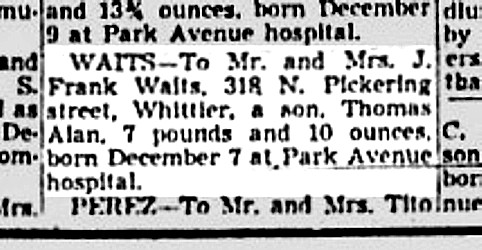 |
Birth announcement "The Progress- Bulletin, Pomona, Calif." Wednesday Evening, Dec. 14, 1949 |
| '60 | While in Jordan Elementary school (Whittier), parents divorce. Tom moves with his mother and two sisters to National City (San Diego). Other sources claim, they moved in 1961 instead of 1960 |
| '65 | At the age of 14 or 15 Tom gets his first job at "Napoleone Pizza House" in National City (San Diego). He would keep this job for about 5 years. These years would prove to be a great inspiration for his later works, such as: "Shore Leave", "The Ghosts Of Saturday Night". The place was run by Joe Sardo and Sal Crivello (the man who still runs the place up to this day). Crivello: "He was fifteen years old. He was doing songwriting. He was playing several clubs then... coffeehouses and things like that. We'd always talk about it while we were working. I saw him going in that direction. I knew he was talented, but I just never thought he'd be that big." (Personal interview by Jay Jacobs. Telephone conversation. May 20, 1999. Published in "Wild Years, the Music and Myth of Tom Waits", 2000). |
| '66 | When in high school (Hilltop High School within the Sweetwater Union High School District, Chula Vista) Tom plays in a band called: "The Systems". |
| '68 | At about the age of 18 Waits got fascinated by the Beat writers. "I started wearing dark glasses and got myself a subscription to Down Beat". This is when Waits started writing his first songs. |
| Nov. 20 - 21, '70 | Bob Webb: "Tom's first paid appearance on The Heritage stage - I believe his first paid gig anywhere - took place during 20-21 November 1970. He appeared as "Thomas Waits" and opened the show for a duet called "Michael Claire," featuring English folk-pop singer Michael Milner and his American partner (later wife) Claire Hart. On 22 November Tom signed the cash book "Thomas Waits" and received $25.00 for his appearance. He continued to sing occasionally at "hoot" nights, and also appeared as Bob LaBeau's guests on some Thursday nights." (Source: "TOM WAITS AT THE HERITAGE" By Bob Webb. As sent to Tom Waits Library Jul. 23, 2003). Further reading: Performances 1949-1975 |
| Jan. 01 - 02, '71 | Bob Webb: "His second weekend booking began on New Year's Day evening, 1-2 January 1971. He again appeared as "Thomas Waits" and opened for LaBeau and a third act called "Ostergren & Thomas," which was the guitar/ banjo/ singing duet of Pami Ostergren and Bobi Thomas. Tom received $18.00 for the two nights of work." (Source: "TOM WAITS AT THE HERITAGE" By Bob Webb. As sent to Tom Waits Library Jul. 23, 2003) |
| Feb. 10 - 13, '71 | Bob Webb: "Tom next performed at The Heritage during a special program on 10 February 1971, which we billed as the "Happy Birthday Mary and Full Moon Concert." He was a featured performer among several. Mary, by the way, was one of the favorite waitresses, and a long-time employee. Two days later he opened a weekend engagement (12-13 February 1971) for the banjo-player Brian Steeger." (Source: "TOM WAITS AT THE HERITAGE" By Bob Webb. As sent to Tom Waits Library Jul. 23, 2003) |
| Apr. 02 - 03, '71 | Bob Webb: "Tom accepted two more bookings at The Heritage while I owned it. During 2-3 Apr. 1971 he opened for Mary McCaslin, who went on to have her own successful career as a singer and guitarist. He signed the cash book "Thomas A. Waits" and received $28.00." (Source: "TOM WAITS AT THE HERITAGE" By Bob Webb. As sent to Tom Waits Library Jul. 23, 2003) |
| May 21 - 22, '71 | Bob Webb: "His final appearance for me was on the weekend of 21-22 May 1971. For the first time, he headlined the show. Bob LaBeau agreed to perform the opening set. But top-billing didn't affect his pay: the cash book shows that "Thomas A. Waits" received $25.00, actually less than he was paid in Apr.."(Source: "TOM WAITS AT THE HERITAGE" By Bob Webb. As sent to Tom Waits Library Jul. 23, 2003) |
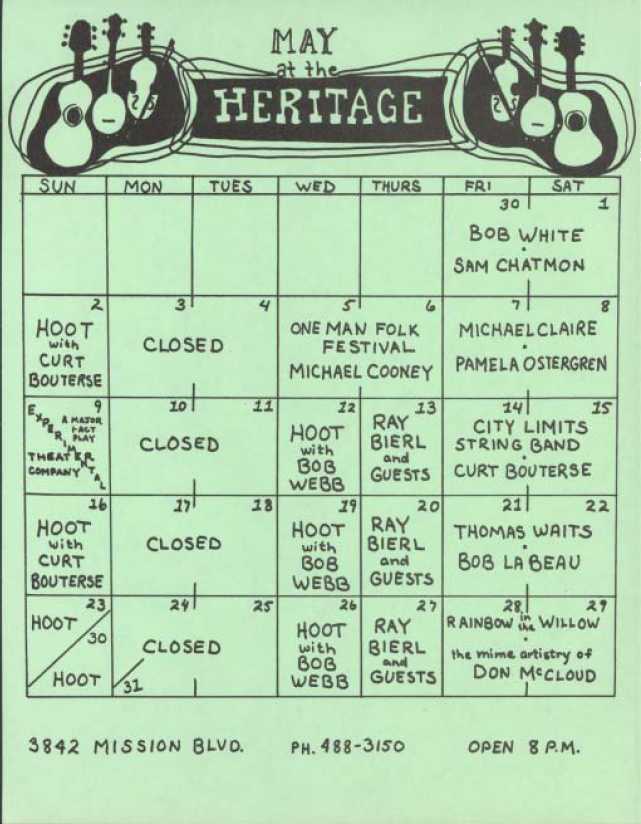 |
Heritage handbill advertising Tom Waits's first featured-act performance. May 21-22, 1971. Scan kindly provided by Bob Webb Copyright �2003 Robert Lloyd Webb |
| Jun. '71 | Bob Webb: "The following month, Jun. 1971, I sold my interest in The Heritage. Attendance had failed to generate enough revenue to pay outstanding obligations. To some extent the general audience had begun to drift away from traditional and folk music, but it is also true that Mission Beach had begun a rapid deterioration toward drug-dealing, gangs, and street violence. The larger community no longer felt completely safe at night on Mission Boulevard. Within twelve months, The Heritage closed for good." (Source: "TOM WAITS AT THE HERITAGE" By Bob Webb. As sent to Tom Waits Library Jul. 23, 2003) |
| Jun. '71 | Waits got the break into show business as he was discovered by rock manager Herb Cohen at Troubadour's hoot night (Los Angeles, Santa Monica Boulevard 9081). Cohen suggested they work together and signed him to his management. At that time Waits was still living in San Diego and traveled to LA each Monday by bus |
| Jun. - Jul. '71 | Waits moves from San Diego to a little one-bedroom bachelor pad in the Silver Lake district of Los Angeles. Tom Waits (1975): "It's a hovel. My landlord is about ninety. He's always coming over and asking if I live here. And my neighbor up front is a throwback to the fifties, an old harlot in pedal pushers and gold-flecked spiked heels and a big bouffant hairdo... and one of the worst mouths I've ever heard" (Source: Waits by Rich Wiseman. Rolling Stone magazine January 30, 1975) |
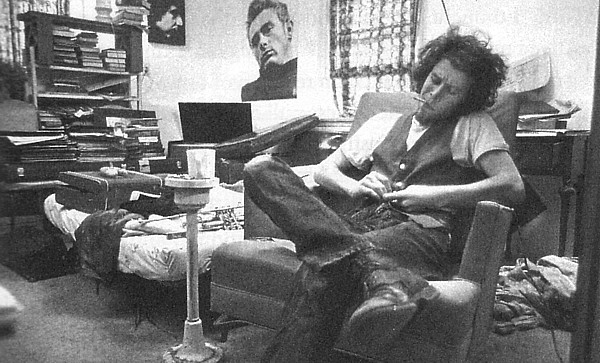 |
Waits at his Silver Lake apartment, as printed in �Lowside Of The Road: A Life Of Tom Waits" by Barney Hoskyns. Faber/ Broadway, 2009. Date: spring 1973. Credits: photography by Kim Gottlieb |
| Jul. - Dec. '71 | Waits does his first demo-recordings for Herb Cohen's label (Straight/ Bizarre) to be used for promotional purposes. These tracks were later released (against Waits's wishes) on the albums: The Early Years I + II |
| Jun. 02 - 04, '72 | Opening for The Floating House Band at "In The Alley, Folk Theatre" Escondido/ USA |
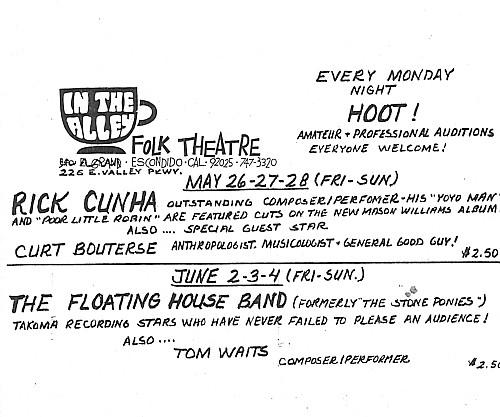 |
In The Alley flier mentioning Tom Waits opening for The Floating House Band.Dave Robinson: "In The Alley was a great music club in Escondido, a town about 40 miles northeast of San Diego. Tom opened for a group called The Floating House Band, a trio of former members of The Stone Ponies who were left behind when Linda Ronstadt went solo. Shep Cooke was one of the members of TFHB - he later played and sang on "Closing Time". Who knows? Maybe this gig is when Tom and Shep first met." (Flier kindly provided by Phil Gross, comment by Dave Robinson, 2003) |
| '72 | Folk singer-songwriter David Blue turns to Elliot Roberts (Asylum) and plays him the '71 Waits demo-recordings |
| '72 | "One night, while Tom was participating in a Troubadour hootenanny, David Geffen happened by... Geffen wasn"t planning on staying long when he dropped by the Troubadour that night in 1972, but he quickly changed his mind. Commanding the stage was a guy who looked more like a vagabond than a rock musician. But Geffen had barely taken his seat before Waits's seductive aura had encompassed him. "He was singing a song called 'Grapefruit Moon' when I heard him," Geffen recalled recently. "I thought it was a terrific song, so I listened to the set." He watched, he listened, and the wheels started turning. Here was an artist who could make some intriguing records. "After [the show], I said that I was interested in him. He said, 'Well, I'll have my manager, Herb Cohen, call you."' Geffen left the Troubadour thinking that since Cohen had his own record company, this would be "the end of it." But, to his surprise, Cohen did finally call: "He was interested in making a deal with me for Tom... Herb had said that he didn't really think that it was right for him to make the record. My making the record would help him with the publishing. So I made a deal for [Tom]. And he made a great first record." Geffen got Elliot Roberts involved in signing Waits to Asylum. Roberts... Once Tom had been signed to Elektra/Asylum, Herb Cohen contacted Jerry Yester. Cohen had been impressed with Yester's production work, and he felt that Yester could bring out the best in his young prot�g�."(Source: "Wild Years, The Music and Myth of Tom Waits". Jay S. Jacobs, ECW Press, 2000) |
| Late '72 | Jerry Yester: "We used to go play pool a lot. We used to go drinking a lot - when drinking was fun instead of suicidal. There was a place in Burbank that was fifty cents an hour for a nine-foot table covered with cigarette burns. And cheap beer, cheap Coors. Tom really loved those kinds of places. It had that kind of funkin' atmosphere." Yester says that one of his favorite memories of Tom came out of an incident that occurred early on while they were working on Closing Time. Yester was mixing the album at Wally Heider Recording, which was located right in the middle of one of Hollywood's shabbier districts, a neighborhood that Waits had yet to explore. "We'd start working on the tunes and he didn't like to hang around," says Yester. "He didn't want to hear it that many times. He was out just soaking up the atmosphere of Coyne and the Boulevard, which was hookers and all the strange population down in Hollywood at that time - God, it's a hundred times weirder now! It was very colorful." One day, Yester explains, "Tom was gone for an hour, and he came back in and he was like ... white. And just shaking a little. I said, 'Jesus, Tom, what's the matter?' And he's, like, 'I just came on to a guy.'" Laughs Yester, 'He's like, 'This guy was one of the most beautiful women I ever saw in my life! We were going to go up to her place, and right before she said, 'You know I'm a man?'" that really shook [Tom's] foundation." (Source: "Wild Years, The Music and Myth of Tom Waits". Jay S. Jacobs, ECW Press 2000. Telephone conversation. June 1, 1999) |
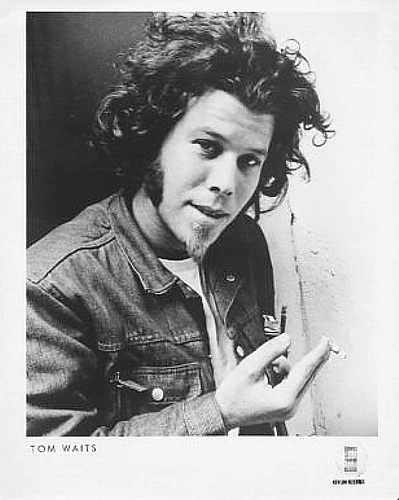 |
Asylum promo picture, 1972 or early 1973 |
1973 |
|
| Mar. '73 | Released: the album: "Closing Time" (Elektra Entertainment). Production by Jerry Yester: "Tom's real easy to work with, we had a real good relationship. I really wasn't interested in telling him what to do. I just wanted to get the music out of him. That was the important thing. So, we talked about how he wanted to do it and I would make suggestions. There was a very good relationship between all of the band members. That album was absolutely the easiest one I've ever done in my life. It was done in, like, a week and a half ... in the studio at Sunset Sound. One reason it was good, I think, was we couldn't get the nighttime hours that I was looking for. We had to come in from ten to five every day. It took two days to get used to it, but once we did it was great. We were even awake when we got there, and it was like a job. Everybody was real alert and into it. We took our lunch breaks, came back and worked again. And we had the evening to do something with. It was like being human, you know?"(Source: "Wild Years, The Music and Myth of Tom Waits". Jay S. Jacobs, ECW Press 2000. Telephone conversation. Jun. 1, 1999) |
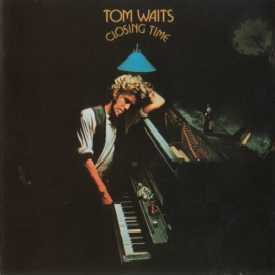 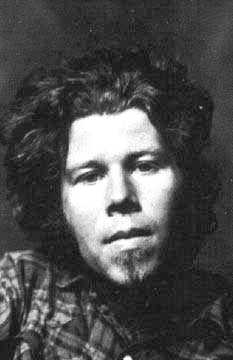 |
L: cover for the album: "Closing Time". Package design by: Cal Schenkel (the picture is said to be taken in Cal Schenkel's living room). Photography by: Ed Caraeff. R: portrait at the age of 23, from the back cover of the album: "Closing Time". Photography by Ed Caraeff |
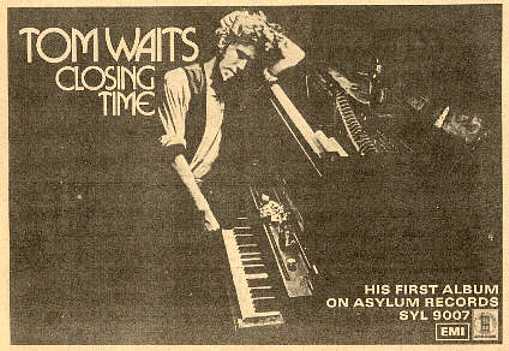 |
Early magazine ad promoting Closing Time (NME magazine, May 12, 1973) |
| '73 | Released: the album "Sefronia" (Discreet = Zappa/ Cohen) by Tim Buckley with a cover of "Martha" (first known TW cover ever). This cover can also be heard on the '95 tribute album "Step right up". Tim Buckley (managed by Herb Cohen) and Waits where friends around this time. Robert Duffey: "In about 1973, Tim and Tom knew each other, and even played together on a record-company softball team" |
| Apr. '73 | First tour promoting Closing Time: April 1973 - June 1973: Tom Waits: vocals, acoustic guitar, piano. Bob Webb: standup bass. Rich Phelps (Felts?): trumpet. John Forsha: guitar. Further reading: Performances 1949-1975
During their second stop on the first national tour in Cambridge, Massachusetts (Passim Coffeeshop), Waits and Bob Webb took one day to travel to nearby Lowell, MA to try to locate the grave site of Jack Kerouac (Source: Ken Langford, 2005. Email conversation with Bob Webb. July 22, 2004) |
| Jun. '73 | Waits is featured on the cover of Music World ("Tom Waits - Thursday Afternoon, Sober as a Judge" written by Jeff Walker. June 1973). Barney Hoskyns (2009): "That summer Waits was interviewed by Jeff Walker for the free magazine Music World. "He was so open." Walker recalls, "We talked about music and jazz and beat poetry. He picked up a trumpet and played a little riff on that. We loved him. "Waits, says Walker was smarting from a tattoo he'd just had done in a downtown parlour. "Thursday afternoon, sober as a judge," he said of the heart and flowers design. "And yes, it hurts." As Jeff and his photographer girlfriend Kim Gottlieb drove home to Laurel Canyon, they decided to make Waits the cover star of the June issue. "Because we were a free magazine, we didn't have to put somebody well known on the cover," says Gottlieb. "We could afford to take somebody that not too many people knew and put them on the cover." Adds Walker, "We went away and said to ourselves, 'This is going to be an important record and this guy's going to be an important artist.' You felt really privileged to be meeting him." Walker saw Waits' boho¬ beatnik act as a conscious assertion of identity. "It seemed to me this was all very deliberate, pushing the boundaries and genres that he had come out of," he says. "But he was fairly forthcoming. He wasn't holding back or mysterious." (Source: Jeff Walker interview March 15, 2007 as quoted in “Lowside Of The Road: A Life Of Tom Waits" by Barney Hoskyns. Faber/ Broadway, 2009) |
 |
The cover of "Music World" magazine. June, 1973. "Tom Waits - Thursday Afternoon, Sober as a Judge" written by Jeff Walker. Date: early 1973. Credits: photography by Kim Gottlieb |
| Nov. '73 | Second tour promoting Closing Time November 1973 - December 1973 (opening for Frank Zappa). Tom Waits: vocals, acoustic guitar, piano. Bob Webb: standup bass. Further reading: Performances 1949-1975 |
| Nov. 22, '73 | Bob Webb (2004): "On November 22 we flew from Buffalo to New York La Guardia, where we were met by a convoy of limousines that drove us downtown to the Waldorf Astoria Hotel, where we were given rooms. (Tom and I shared a room at most, if not all of these accommodations.) Tom and I didn't play Buffalo, because Taj Mahal had been booked as the opening act. At some point... we were hustled into the limousines again and driven to an undisclosed location in midtown Manhattan. Speculation was rampant, but no one seemed to know where we were going. We went deep into an underground garage in midtown, maybe six floors down, to a giant set of doors like a hotel entrance, which led to big elevators, and we were swept up to a floor that included a giant room full of grand pianos and the most swank dressing rooms I ever saw--showers and fresh fruit and flowers. We were told then that we were in Avery Fisher Hall, in Lincoln Center, and there's where we performed that day, to an audience of nearly 4,000 of the rowdiest, most stoned New Yorkers I ever saw. It was the first gig I ever played with an electric bass, and I think it must have been Tom's first time on an electronic keyboard (he was strictly a piano-man in those days). It was also the largest stage we had ever been on, and we faced the most unruly crowd either of us had ever performed for. I'm sure neither of us will ever forget it!" (Source: Ken Langford, 2005. Email conversation with Bob Webb. July 22, 2004) |
1974 |
|
| Feb. '74 | Third tour promoting Closing Time February 1974 - September 1974 (opening for Frank Zappa). Tom Waits solo: vocals, acoustic guitar, piano. Further reading: Performances 1949-1975 |
| May 13-22, '74 | Studio recordings for The Heart Of Saturday Night(Wally Heider Recording. Hollywood/ USA) |
| Aug. 06 - 07, '74 | TV appearance for "KCET TV", Los Angeles/ USA (unverified) |
| Aug. '74 | End third tour promoting Closing Time: February 1974 - September 1974. Further reading: Performances 1949-1975. Frank Zappa and The Mothers of Invention go for a European tour (Sep. 08 - Oct. 03, '74). Waits stays behind to record his next album |
| Oct. '74 | Released: "The Heart Of Saturday Night" (Elektra/ Asylum Records). Waits at the age of 24. Produced by Bones Howe
Jay S. Jacobs (2002): "One of the first agreements that Tom and Bones struck was that this album was going to be a lo-fi product - a gritty assortment of expressions bearing no trace of studio polish. Even the artwork for The Heart of Saturday Night would have that low-life after-hours feel - a drawing of a tired and slightly dazed-looking Waits being sized up by a blonde hooker as he steps out of a neon-lit cocktail lounge at closing time... Howe needed an arranger for Tom's new compositions, someone who could instinctively relate to what he and Waits were trying to achieve. He approached Michael Melvoin, legendary studio musician whose job list reads like a who's who of twentieth-century popular music... Howe and Melvoin had worked together before - with The Fifth Dimension and several other acts - and despite the fact that Melvoin hadn't yet heard of Tom Waits, Howe felt that he had the sensitivity and the expertise to help them shape The Heart of Saturday Night. When Howe gave him a preliminary taste of Waits's material, Melvoin says, I knew that I was dealing with an extraordinary, different kind of talent. There were a couple of things about it. First of all, the lyrics ... I would describe them as top-rank American poetry. I thought then, and I still believe, that I was dealing with a world-class poet. My degree from school was in English literature, so I felt that I was in the presence of one of the great Beat poets." As a student Melvoin had played jazz behind Beat poet and essayist Kenneth Rexroth. Tom's work was "a counterpoint to that experience. I was amazed by the richness of it. The musical settings that he was using reminded me of certain roots jazz experiences that I thought were very, very appropriate for that." (Source: "Wild Years, The Music and Myth of Tom Waits". Jay S. Jacobs, ECW Press 2000. Telephone conversation. Jun. 25, 1999) |
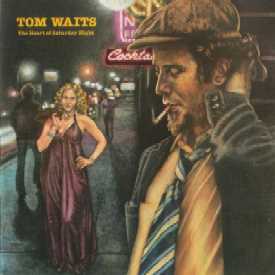 |
Cover for "The Heart Of Saturday Night". Cover illustration by: Napoleon |
| Late '74 | Released: single: "San Diego Serenade" (Asylum) |
| Sep. 07, '74 | TV appearance. "Speakeasy", syndicated US television talk show, hosted by Chip Monck. Interview with Frank Zappa, with Waits performing "Ol' '55" and "Ghosts Of Saturday Night" |
| Oct. '74 | Start first tour promoting The Heart Of Saturday Night: October 1974 - December 1974 (album released: October, 1974). Tom Waits solo: vocals, acoustic guitar, piano. Further reading: Performances 1949-1975 |
| Dec. 18, '74 | One of the first magazine interviews with Waits, for Dutch magazine "Muziekkrant OOR" (nr. 25 + 26) by Constant Meijers. Tom Waits: "I've tasted Saturday nights in: Detroit, St. Louis, Tuscaloosa, New Orleans, Atlanta, N.Y.C., Boston, Memphis. I've done more traveling in the past year than I ever did in my life sofar". "My favorite album is: Kerouac-Allen on Hanover Records" |
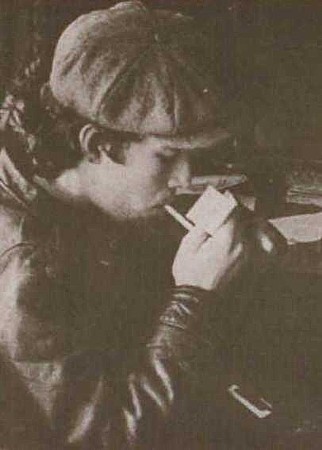 |
Picture from the December interview by Constant Meijers |
| Dec. '74 | End first tour promoting The Heart Of Saturday Night: October 1974 - December 1974 (album released: October, 1974). Tom Waits solo: vocals, acoustic guitar, piano. Further reading: Performances 1949-1975 |
1975 |
|
| Jan. 30, '75 | One of the first American magazine articles by Rich Wiseman: "Tom Waits, All-Night Rambler" for Rolling Stone. |
| Jan. '75 | Start second tour promoting The Heart Of Saturday Night: January 1975 - September 1975 (album released: October, 1974). Tom Waits solo: vocals, acoustic guitar, piano. Further reading: Performances 1949-1975 |
| '75 | Frank Zappa takes legal actions against his former manager Herb Cohen. The trial would go on for a number of years, after which Waits too would break up with Cohen |
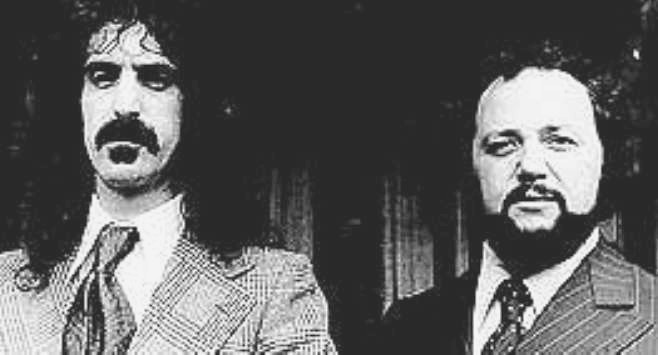 |
Frank Zappa and long time manager Herb Cohen, outside the Law Courts. Strand, London. Apr. 1975. From: "Mother! The Frank Zappa Story". Photography: unknown |
| '75 | In New York Waits attends the reception promoting the book: "Tales Of Beatnik Glory - Vol. 1" by Ed Sanders. Other guests: beat poet William Burroughs, Allen Ginsberg and Patti Smith |
| Jul. 30 - 31, '75 | Live Recordings for the album "Nighthawks At The Diner" in The Record Plant/ Wally Heider Recording, Hollywood/ USA |
| Sep. '75 | Waits joins benefit show(s) for The Main Point, Bryn Mawr. near Philadelphia. "The club was so well-loved among artists that when there was a bit of financial difficulty, Tom Rush, Joni Mitchell, Dave Van Ronk and Tom Waits all volunteered to perform in a benefit concert and straightened it right out."(Source: "Getting To The Point" cover story by Mary Armstrong for Philadelphia City Paper. October 17-23, 2003). Further reading: Charity |
| Sep. '75 | End second tour promoting The Heart Of Saturday Night: January 1975 - September 1975. Further reading: Performances 1949-1975 |
| Late Oct. '75 | Released: the live double-album "Nighthawks At The Diner" (Elektra/ Asylum Records). Produced by Bones Howe. Waits at the age of 25. With "Spare Parts I" co-written by Chuck E. Weiss
Jay S. Jacobs (2000): "Waits's manager, Herb Cohen, suggested that he do a live album. One that would showcase the compelling Waits stage persona... Waits himself had some reservations about embarking on the live album project, but he eventually agreed to do it. Bones Howe was enthusiastic from the outset, and he knew just how the job should be done. I said I didn't want to go into a club. I'd seen Tom live and we could make a much better record if ... we made a recording studio into a club. There was a room at the back of the Record Plant. It's a big recording studio, almost a soundstage. We put a little stage over in the corner. There was a booth with glass, so we didn't need to be in the room." Howe scheduled the Record. Plant shows for the last two days of Jul. 1975, and everyone got to work creating the appropriate ambiance. "We put tables in the room and we had a guest list," says Howe. "We had beer and wine and potato chips on the tables. And we sold out four shows ... two nights in a row. Tom got this stripper named Dwana to be the opening act." Dwana was an old-time burlesque queen whom Tom had met on one of his jaunts to the Hollywood underworld. She warmed up the crowd - which was largely made up of friends and acquaintances of Waits and crew - and everyone was primed for a drunken voyage into an Edmund Hopper painting or a Charles Bukowski poem. Waits didn't plan on disappointing them. Bones had put together a live band from the session musicians who had worked on The Heart of Saturday Night. Mike Melvoin served as bandleader and also covered keyboards. Pete Christlieb blew tenor sax, Jim Hughart hauled the upright bass, and Bill Goodwin played drums. Melvoin recalls the scene: "Candles on the tables ... A room full of people. The show started with a stripper, who was the classic old tassle-twirler. It was wonderful. The ambiance was great. The band was sensational. The interaction between the band and Tom was wonderful - between the band and Tom and the audience. It was great chemistry, and I have to hand it to Bones for putting that together."... Later on, says Howe, when the time came to mix the album, he and Tom "just went out and hid in a recording studio. We took the best of each of the four shows, put an album together out of it and then mixed it. We had a really, really good time doing it. The album shows that." The album's working title had been "Nighthawk Postcards from Easy Street," but they shortened it to Nighthawks at the Diner. Listening to the finished product, it's evident that the sessions it documents were a hoot for everyone involved, but, as often happens with live albums, fun in concert didn't quite translate onto vinyl." (Source: "Wild Years, The Music and Myth of Tom Waits". Jay S. Jacobs, ECW Press 2000) |
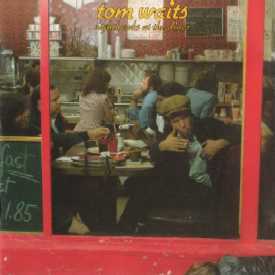 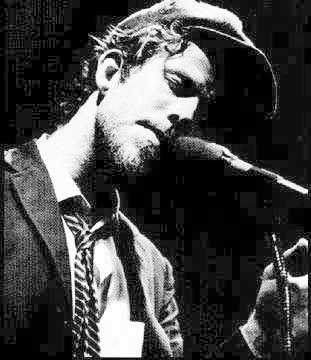 |
L: cover of the album: "Nighthawks At The Diner". Design by: Cal Schenkel. Photography by: Norman Seeff. On the picture are: Cal Schenkel, Kathy and Napoleon on the ground in front of the diner). R: portrait at the age of 25, from the back cover of the album: "Nighthawks At The Diner". Photography by Matt Kramer |
| Oct. '75 | Start tour promoting Nighthawks At The Diner: October 1975 - June 1976 (album released: October, 1975). Tom Waits: vocals, acoustic guitar, piano. Frank Vicari: tenor saxophone. Dr. Fitz(gerald) Jenkins: upright bass. Chip White: drums. Further reading: Performances 1949-1975 |
| Nov. 29, '75 | Interview for New Musical Express: "Not So Much A Poet, More A Purveyor Of Improvisational Travelogue", by Todd Everett |
| Dec. 18, '75 | Rolling Stone review by Jon Landau: "Positively 84th Street - Poet of the Crack of Dawn"
John Landau (1975): "I saw Tom Waits for the first time last night, and he knocked me out. He is the best contemporary expression of the loner I've yet encountered. But beyond his extraordinary ability as writer, monologist and performer, he exhibits the single ingredient most missing from the music of today's new stars--personality. He's so original, consistent and animated, he reminds us that, while there are a lot of first-rate craftsmen coming up through the ranks, most of them lack the distinctive point of view necessary for the creation of art... Waits onstage is something to behold. He bobs, weaves, smokes and snaps his fingers from the moment he enters until the moment he leaves. He has now advanced to a point where his entire set revolves around his command of the language. He raps as much as he sings, but these are no average raps. He has become a master storyteller, and the whole set now feels like one long story--beautifully told. He functions throughout at one of the highest levels of energy I've ever seen in a top performer." (Source: "Positively 84th Street - Poet of the Crack of Dawn" by John Landau. Rolling Stone magazine. December 18, 1975) |
| Dec. 22, '75 | Aired: TV concert appearance for "Soundstage", Chicago.PBS television show on Tom Waits and Mose Allison. Chicago/ USA (aired December 22, 1975, recorded November 3, 1975 or earlier).
Jay S. Jacobs (2000): "He was invited to perform live on the PBS show Soundstage. Heightening the thrill factor for Waits was the knowledge that he would be sharing the bill with his Iong time idol Mose Allison. The segment's highlight is the opening number, Waits's dramatic a capella performance of "Eggs and Sausage." Wearing a ratty black sports coat, a loose tie, and a brown beret, he sits at the counter of a real diner, cigarette in hand. Around him we glimpse tired waitresses, bored patrons, sizzling burgers. His only musical accompaniment is the snapping of his fingers and the slapping of his leg. Finishing the tune, he turns to a waitress and asks for another cup of coffee." (Source: "Wild Years, The Music and Myth of Tom Waits". Jay S. Jacobs, ECW Press 2000) |
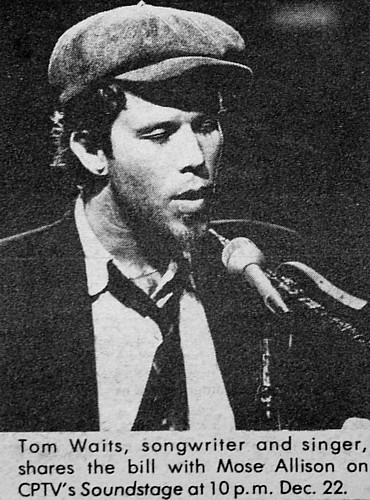 |
Display ad from the Hartford Advocate December 1975, for a broadcast on local TV on December 22, 1975. Thanks to Ken Langford for donating scan |
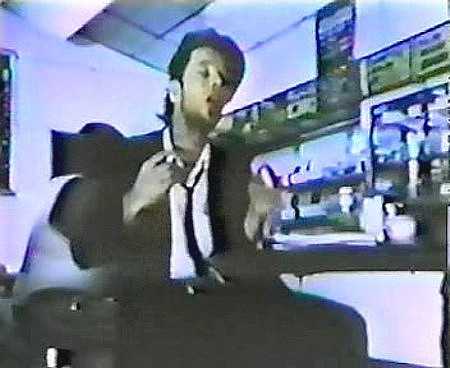 |
Screenshot from the Soundstage TV appearance. Thanks to Jaime Mayo for donating scan |
|
Further reading |
|

